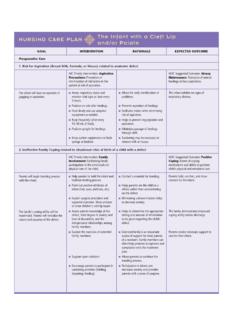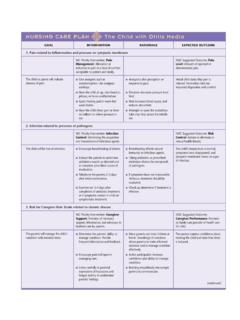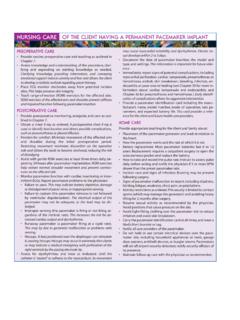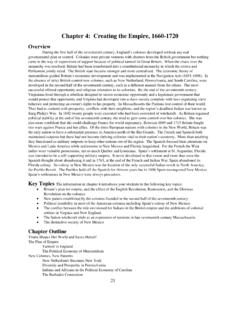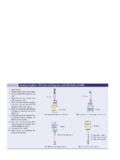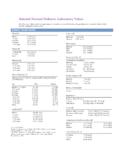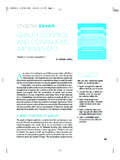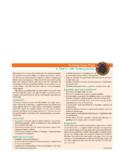Transcription of Nursing Care Plan A Client with a Hip Fracture
1 1212 UNIT XI / Responses to Altered Musculoskeletal FunctionStella Carbolito is a 74-year-old Italian American with a history ofosteoporosis. She is a widow and lives alone in a two-story rowhome. Mrs. Carbolito is retired and depends on a pension checkand social security for her income. She takes pride in making allher own food from walking to the market one day, Mrs. Carbolito falls andfractures her left hip. She is transported by ambulance to the near-est hospital emergency the initial assessment at the ED, abnormal findings are thatMrs. Carbolito s left leg is shorter than her right leg and is exter-nally rotated. Distal pulses are present and bilaterally strong; bothlegs are warm.
2 Mrs. Carbolito complains of severe pain but statesthat no numbness or burning is present. She is able to wiggle thetoes on her left leg and has full movement of her right leg. Initialvital signs are as follows: T F ( C), P 100, R 18, BP 120 tests include CBC, blood chemistry, and X-ray studies ofthe left hip and pelvis. The CBC reveals a hemoglobin of g/dLand a normal WBC count. Blood chemistry findings are withinnormal limits. The X-ray reveals a Fracture of the left femoral Carbolito is admitted to the hospital with an order for 10 lbof straight leg traction. An open reduction and internal fixation(ORIF) is planned for the following Acute pain,related to fractured left femoral neck and musclespasms Impaired physical mobility,related to bed rest and fractured leftfemoral neck Risk for ineffective tissue perfusion,related to unstable bonesand swelling Risk for disturbed sensory perception: Tactile,related to the risk ofnerve impairmentEXPECTED OUTCOMES Verbalize a decrease in pain.
3 Verbalize the purpose of traction and surgery Maintain normal neurovascular assessments. Demonstrate postoperative AND IMPLEMENTATION Assess pain on a scale of 0 to 10 before and after implementing measures to reduce pain. Administer narcotics per the physician s order. Perform neurovascular assessment every 2 to 4 hours, and doc-ument findings. Apply straight leg traction per physician s order. Encourage deep breathing and relaxation techniques. Teach the purpose of traction and surgery. Teach the purpose of and the procedure for performing iso-metric and flexion/extension days after surgery, Mrs. Carbolito is out of bed and in a verbalizes a decrease in pain.
4 There have been no abnormalneurovascular assessments. She is able to independently performisometric and flexion/extension exercises in both lower extremi-ties. Discharge planning included referrals for home care. A homehealth nurse will visit, and the social worker at the hospital has ordered a trapeze for her bed, an elevated toilet seat, an elevatedcushion for her chair, and a Thinking in the Nursing Process1. What factors placed Mrs. Carbolito at risk for a hip Fracture ?2. Mrs. Carbolito says, I don t understand why they had to putthat heavy thing on my leg before I went to surgery to get myhip fixed. What would you tell her? What preoperative factorsmight have decreased teaching effectiveness?
5 3. Describe how each of the following, if manifested by , would increase her risk for postoperative complica-tions: urinary incontinence, weight more than 20% undernormal for her height, chronic constipation. What Nursing di-agnoses and interventions would you include in her plan ofcare to decrease the risk?See Critical Thinking in the Nursing Process in Appendix Care PlanA Client with a Hip Fractureserious threat to independence, because these limbs performmore specialized functions. The incidence of traumatic ampu-tations is highest among young men. Most amputations in thisgroup result from motor vehicle crashes or accidents involv-ing machinery at work.
6 The Client may present to the traumacenter with an injury that may be life threatening; significantloss of blood and tissue may have already occurred, and shockmay develop. (See Chapter 6 for a discussion of shock andtrauma.) Other traumatic events that may necessitate an ampu-tation are frostbite, burns, or result from or are necessitated by interruptionin blood flow, either acute or chronic. In acute trauma situa-tions, the limb is partially or completely severed, and tissuedeath ensues. Replantation of fingers, small body parts, and en-tire limbs has been the chronic disease processes, circulation is impaired,venous pooling begins, proteins leak into the interstitium, andedema develops.
7 Edema increases the risk of injury and furtherdecreases circulation. Stasis ulcers develop and readily be-come infected because impaired healing and altered immuneprocesses allow bacteria to proliferate. The presence ofprogressive infection further compromises circulation and ul-timately leads to gangrene (tissue death), which requires OF AMPUTATIONThe level of amputation is determined by local and systemicfactors. Local factors include ischemia and gangrene; systemfactors include cardiovascular status, renal function, and sever.


